Every time the government hints at restricting media behaviour, it leads to a rare unity among the hundreds of TV channels and tens of thousands of print publications in India that cry foul and take refuge in their right to free speech. The government in turn retreats, leaving behind a trail of discussion on media freedom. The last time we had seen such an animated situation was in 2011 when even the moderates wanted a Press Council of India equivalent for our TV channels. The TV honchos stonewalled the suggestion and said they were capable of self regulation. However, suggestions such as regulation are ringing the air yet again. [caption id=“attachment_2053705” align=“alignleft” width=“380”]  Sunanda Pushkar in a file photo. PTI[/caption] On Sunday, union minister Arun Jaitley said the government was devising norms for media covering terror attacks. However, the context he used was not terror, but slander. It was obvious that his reference was to the indiscretion of some TV channels in sensationalising the death of Congress MP Shashi Tharoor’s wife Sunanda Pushkar. He didn’t name the channels or Sunanda, but made his intention pretty clear with his comments. “Privacy of individuals even in high profile cases is part of their right,” he said, adding, “what was the relationship between a husband and wife, what was the kind of conversation they were having, these are areas which have absolutely no bearing on larger public interest and can only add some spice to the content of reporting,” “The parallel trial concept prejudices the entire environment in which a person is to get justice. As far as certain trial courts are concerned, they are under tremendous pressure particularly in high profile cases where the media has conducted a parallel trial and almost declared somebody guilty of innocent,” he further said, suggesting that the media should devise its code of ethics covering high profile cases. Often, the media in India come under indirect censorship and controls — mostly by right wing organisations and powerful lobbies — (Hoot last year documented 52 such cases in three months) but when it comes to targeting individuals and running parallel trials, it’s absolutely no-holds-barred. The Sunanda Pushkar case is a remarkable example because it has become the centrepiece of prime time TV in which anchors and a herd of talking heads solve the case in their studios day after day. In the process, they shamelessly narrate personal conversations, present confidential medical reports, show pictures of the body from the autopsy table and fill the air with vacuous conspiracy theories. The talking heads are selected for their proclivity to agree with the head juror in the studio. Needless to say, these shows malign people, dish out inanities and make a mockery of science and legal processes. The spectacle of a loud and supercilious anchor playing the role of a cop, autopsy surgeon, forensic expert, scientist, investigator and most importantly, the judge is not just ludicrous, but highly offensive to both the people targeted and the viewers. Had it been in the UK, the Ofcom, the communications regulator, could have been called in for help. Two critical duties of Ofcom are to ensure that “people who watch television and listen to the radio are protected from harmful or offensive material; people are protected from being treated unfairly in television and radio programmes, and from having their privacy invaded.” Incidentally, nobody complains about free speech in the UK. Who do we turn to? The media trial of the death of Sunanda Pushkar is a fit case for a serious debate on the need for a formal entity that can quote norms and responsibilities to TV channels that violate media ethics by a mile and wilfully target individuals. The promise of self regulation has miserably failed. Truth and ethics have been slayed in the game of TRP and one-upmanship of anchors. Vice President Hamid Ansari had voted for a regulator four years ago, when he said “collective self-regulation has yet to succeed in substantive measure because it is neither universal nor enforceable. Individual self-regulation has also failed due to personal predilection and the prevailing of personal interest over public interest.” Former Supreme Court judge and Press Council chief Markandey Katju also had the same opinion. “If the broadcast media insist on self-regulation, then by the same logic, politicians, bureaucrats… must have the same right of self-regulation,” he had said in an article in The Hindu. Ironically, while the TV anchors run amuck, central and state governments use the draconian provisions of the IT act, especially 66 (A) — to muzzle free speech, harass people and even to put them in jail. If even a fraction of what appears on TV in the Sunanda Pushkar case, particularly the “obnoxious channel” as Tharoor referred to one of them, appears in social media, it can invite legal action under 66 (A). It’s not only about the rights of people singled out by these channels, but also about the right of the viewers to be protected from offensive content and noisy studios.
The media trial of the death of Sunanda Pushkar is a fit case for a serious debate on the need for a formal entity that can quote norms and responsibilities to TV channels that violate media ethics by a mile and wilfully target individuals.
Advertisement
End of Article


)

)
)
)
)
)
)
)
)



